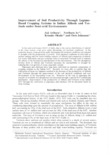In the semi-arid tropics (SAT) of India, due to the uneven distribution of rainfall in the rainy season, crops grow under fluctuating soil moisture conditions. In the postrainy season, crops growing under decreasing soil moisture conditions are exposed to drought with the progression of growth. Poor physical conditions of soils such as surface sealing and low water-holding capacity of Alfisols and compaction of subsoil, low water infiltration and gas exchange rates of saturated Vertisols tend to enhance the effects of the fluctuations and decrease of the soil moisture. The low phosphorus fertility level of Alfisols and Vertisols increases the susceptibility to drought by reducing the root growth of crops, especially cereals.
Pigeonpea and chickpea have long been cultivated as essential components of cropping systems in the Indian SAT. Recently we were able to confirm that the cultivation of those two legumes resulted in the increase of the productivity of Alfisols and Vertisols through the improvement of the soil physical conditions and root development of the succeeding crops, etc. Moreover in the case of pigeonpea the amount of available soil phosphorus was increased through a special Fe-P solubilizing mechanism. Improvement of the productivity of Alfisols and Vertisols of the Indian SAT through the cultivation of pigeonpea and chickpea will be discussed based on these findings.

